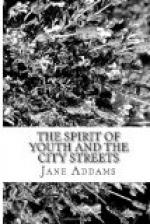We cannot afford to be ungenerous to the city in which we live without suffering the penalty which lack of fair interpretation always entails. Let us know the modern city in its weakness and wickedness, and then seek to rectify and purify it until it shall be free at least from the grosser temptations which now beset the young people who are living in its tenement houses and working in its factories. The mass of these young people are possessed of good intentions and they are equipped with a certain understanding of city life. This itself could be made a most valuable social instrument toward securing innocent recreation and better social organization. They are already serving the city in so far as it is honeycombed with mutual benefit societies, with “pleasure clubs,” with organizations connected with churches and factories which are filling a genuine social need. And yet the whole apparatus for supplying pleasure is wretchedly inadequate and full of danger to whomsoever may approach it. Who is responsible for its inadequacy and dangers? We certainly cannot expect the fathers and mothers who have come to the city from farms or who have emigrated from other lands to appreciate or rectify these dangers. We cannot expect the young people themselves to cling to conventions which are totally unsuited to modern city conditions, nor yet to be equal to the task of forming new conventions through which this more agglomerate social life may express itself. Above all we cannot hope that they will understand the emotional force which seizes them and which, when it does not find the traditional line of domesticity, serves as a cancer in the very tissues of society and as a disrupter of the securest social bonds. No attempt is made to treat the manifestations of this fundamental instinct with dignity or to give it possible social utility. The spontaneous joy, the clamor for pleasure, the desire of the young people to appear finer and better and altogether more lovely than they really are, the idealization not only of each other but of the whole earth which they regard but as a theater for their noble exploits, the unworldly ambitions, the romantic hopes, the make-believe world in which they live, if properly utilized, what might they not do to make our sordid cities more beautiful, more companionable? And yet at the present moment every city is full of young people who are utterly bewildered and uninstructed in regard to the basic experience which must inevitably come to them, and which has varied, remote, and indirect expressions.
Even those who may not agree with the authorities who claim that it is this fundamental sex susceptibility which suffuses the world with its deepest meaning and beauty, and furnishes the momentum towards all art, will perhaps permit me to quote the classical expression of this view as set forth in that ancient and wonderful conversation between Socrates and the wise woman Diotima. Socrates asks: “What are they doing who show all this eagerness and heat which is called love? And what is the object they have in view? Answer me.” Diotima replies: “I will teach you. The object which they have in view is birth in beauty, whether of body or soul.... For love, Socrates, is not as you imagine the love of the beautiful only ... but the love of birth in beauty, because to the mortal creature generation is a sort of eternity and immortality.”




